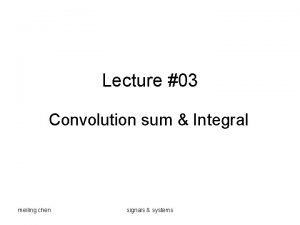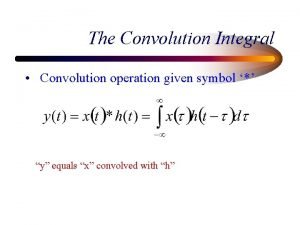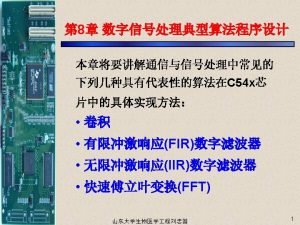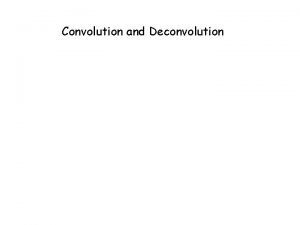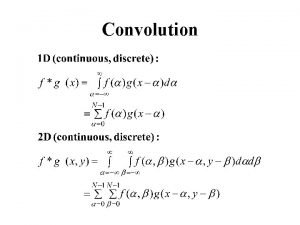X 1 rectangle convolution with itself 2 The











- Slides: 11


X 1 (rectangle) convolution with itself 2 The result will be a triangle (X 3) X 1 -1 The ending point of the X 1(first) signal + the ending point of the X 1 (second) signal 1 * 2 X 1 -1 -1 The starting point of the X 1(first) signal + the starting point of the X 1 (second) signal -1 1 1+1 X 3 -2 0 2

X 1 (rectangle) convolution with itself OR convolution with another rectangle of the same width 2 Then we get the height from Area of X 1 multiplied by Area of X 1 equals Area of X 3 -1 A 1 x A 2 = A 3 2 x 2=4 X 1 1 * 2 0. 5 x 4 x h -1 X 1 1 multiply h X 3 -2 0 2

X 1 (rectangle) convolution with X 2 (rectangle) 2 The result will be a trapezoid (X 3) X 1 -1 The ending of the X 1(first) signal + the ending of the X 2 (second) signal 1 * 3 X 2 -1 -2 -2 2 The starting of the X 1(first) signal + the starting of the X 2 (second) signal X 3 1+2 -3 0 3

X 1 (rectangle) convolution with X 2 (rectangle) 2 We want to get the region of the constant part in the signal X 1 -1 The starting of the X 1(first) signal + the ending of the X 2 (second) signal 1 * 3 X 2 1 - 2 -2 2 The ending of the X 1(first) signal + the starting of the X 2 (second) signal X 3 -1+2 -3 -1 0 1 3

X 1 (rectangle) convolution with X 2 (rectangle) 2 X 1 Then we get the height from Area of X 1 multiplied by Area of X 2 equals Area of X 3 -1 1 * A 1 x A 2 = A 3 3 X 2 2 x 2=4 4 x 3=12 0. 5 x h x (6+2) -2 2 multiply h X 3 -3 -1 0 1 3

Another example X 1 (rectangle) convolution with X 2 (rectangle) X 1 The result will be a trapezoid (X 3) The ending of the X 1(first) signal + the ending of the X 2 (second) signal 2^1/2 -3 3 * X 2 2^1/2 -3 -2 -2 2 The starting of the X 1(first) signal + the starting of the X 2 (second) signal X 3 3+2 -5 0 5

Another example X 1 (rectangle) convolution with X 2 (rectangle) X 1 We want to get the region of the constant part in the signal 2^1/2 -3 3 The starting of the X 1(first) signal + the ending of the X 2 (second) signal * X 2 2^1/2 3 -2 -2 2 The ending of the X 1(first) signal + the starting of the X 2 (second) signal X 3 -3+2 -5 -1 0 1 5

Another example X 1 (rectangle) convolution with X 2 (rectangle) X 1 Then we get the height from Area of X 1 multiplied by Area of X 2 equals Area of X 3 -3 3 * A 1 x A 2 = A 3 6 x(2^0. 5) 4 x(2^0. 5) 2^1/2 X 2 2^1/2 0. 5 x h x (10+2) multiply -2 2 h X 3 -5 -1 0 1 5

Area of trapezoid: A = 0. 5 x h x (a + b) h Or A = 2 x (0. 5 x c x h + d x h) -5 -1 c 0 d a b 1 5

• Note that it could be in the opposite way, the trapezoid is given and you need to simplify it to two rectangles. 8 -7 -1 0 1 1. 5^1/2 -4 4 7 * -3 3
